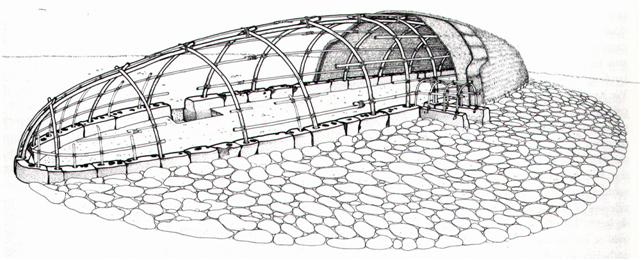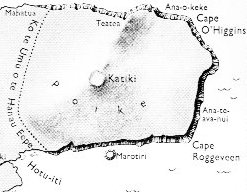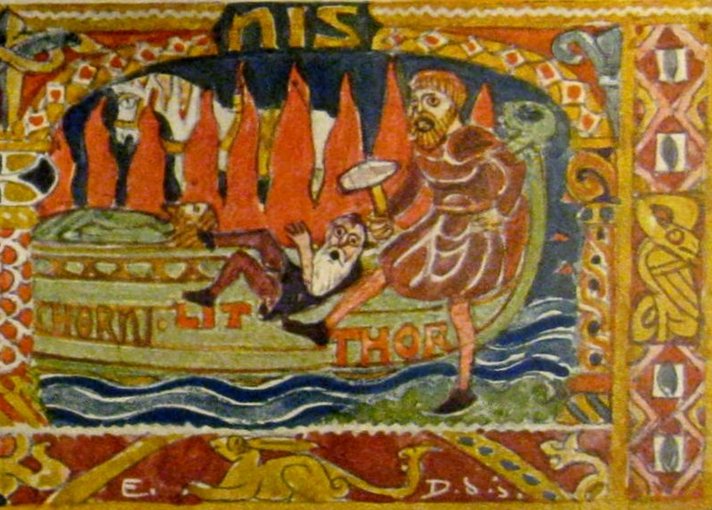When Ure Honu searched for the stolen head (puoko) of the dead king he thought it could be inside the house of Tuu Ko Ihu: ... After Tuu Ko Ihu had reached up with his hands, he cut off the skull and put it into his basket. Out (went) the king, Tuu Ko Ihu, and ran to Ahu Tepeu. He had the skull with him. King Tuu Ko Ihu dug a hole, made it very deep, and let the skull slide into it. Then he cushioned the hole with grass and put barkcloth on top of it, covered it with a flat slab of stone (keho), and covered (everything) with soil. Finally, he put a very big stone on top of it, in the opening of the door, outside the house. Ure Honu looked around for his skull. It was no longer in the house. When he questioned those who knew, the foster child of Ure Honu said, 'On the day on which the banquet for the new house was held, Tuu Ko Ihu saw the skull. He was very much moved and wept, 'Here are the teeth that ate the turtles and the pigs (? kekepu) of Hiva, of the homeland!' When the foster child of Ure Honu had spoken, Ure Honu grew angry. He secretly called his people, a great number of men, to conduct a raid (he uma te taua). Ure set out and arrived in front of the house of Tuu Ko Ihu. Ure said to the king, 'I (come) to you for my very large and very beautiful skull, which you took away on the day when the banquet for the new house was held. Where is the skull now?' (whereupon) Tuu Ko Ihu replied, 'I don't know.' When Tuu Ko Ihu came out and sat on the stone underneath which he had buried the skull, Ure Honu shot into the house like a lizard. He lifted up the one side of the house. Then Ure Honu let it fall down again; he had found nothing. Ure Honu called, 'Dig up the ground and continue to search!'The search went on. They dug up the ground, and came to where the king was. The king (was still) sitting on the stone. They lifted the king off to the side and let him fall. They lifted up the stone, and the skull looked (at them) from below. They took it, and a great clamour began because the skull had been found. Ure Honu went around and was very satisfied. He took it and left with his people. Ure Honu knew that it was the skull of the king (puoko ariki) ... A small detail should here be noticed: When Ure Honu could not see the skull of the king inside the house he let if fall down again. I.e. it was an abrupt change to darkness, which once again returned inside the house. His lifting up one side of the house had probably been in a smooth and gradual movement - because it was heavy - but then he let it suddenly drop down again, thereby abruptly cutting off the Sun light.
... The most vivid description of hut interiors is given by Eyraud ... who slept in them several nights: Imagine a half open mussel, resting on the edge of its valves and you will have an idea of the form of that cabin. Some sticks covered with straw form its frame and roof. An oven-like opening allows its inhabitants to go inside as well as the visitors who have to creep not only on all fours but on their stomachs. This indicates the center of the building and lets enter enough light to see when you have been inside for a while. You have no idea how many Kanacs may find shelter under that thatch roof. It is rather hot inside, if you make abstraction of the little disagreements caused by the deficient cleanliness of the natives and the community of goods which inevitably introduces itself ... The sky dome was gradually growing higher and higher from the winter solstice to the summer solstice. But at the summer solstice there was an abrupt change. ... Then I become aware of ... a presence - a faint, ghostly glimmering, like moonglow, that has appeared on the solstice stone. I don't know how long it lasts, a second or two only I would guess, but while it is there it seems less like a projection - which I know it to be - than something immanent within the stone itself. And it seems to function as a herald for it fades almost as soon as it has appeared and in its place the full effect snaps on - instantaneously. It wasn't there, and then it's there. As Chris had described, the effect does curiously resemble a poleaxe, or a flag on a pole, and consists of a 'shaft', narrow at the base but widening a little towards the top, running up the left hand side of the solstice stone, surmounted by a right-facing 'head' or 'flag'. An instant later an almond-shaped spot of light, like an eye, appears a few centimeters to the right of the 'flag' and the effect is complete. Weirdly - I do not claim it has any significance - this flag-on-a-pole symbol is the ancient Egyptian hieroglyph neter, meaning 'god', or 'a god' - and not to be understood at all in the Judaeo-Christian usage of that word but rather as a reference to one of the supernatural powers or principles that guide and balance the universe. Manifested here, in this strange Stone Age temple, it glows, as though lit by inner fire ...
On Easter Island the highest point was in the east on the Poike peninsula.
... There was noise at night at Marioro, it was Hina beating tapa in the dark for the god Tangaroa, and the noise of her mallet was annoying that god, he could endure it no longer. He said to Pani, 'Oh Pani, is that noise the beating of tapa?' and Pani answered, 'It is Hina tutu po beating fine tapa.' Then Tangaroa said, 'You go to her and tell her to stop, the harbour of the god is noisy.' Pani therefore went to Hina's place and said to her, 'Stop it, or the harbour of the god will be noisy.' But Hina replied, 'I will not stop, I will beat out white tapa here as a wrapping for the gods Tangaroa, 'Oro, Moe, Ruanu'u, Tu, Tongahiti, Tau utu, Te Meharo, and Punua the burst of thunder'. So Pani returned and told the god that Hina would not stop. 'Then go to her again', said Tangaroa, 'and make her stop. The harbour of the god is noisy!' So Pani went again, and he went a third time also, but with no result. Then Pani too became furious with Hina, and he seized her mallet and beat her on the head.
She died, but her spirit flew up into the sky, and she remained forever in the moon, beating white tapa. All may see her there. From that time on she was known as Hina nui aiai i te marama, Great-Hina-beating-in-the-Moon ... Here was Pua Katiki:
... The dream soul went on and came to One Tea. She named the place 'One Tea A Hau Maka O Hiva'. She went on and reached Hanga Takaure. She named the place 'Hanga Takaure A Hau Maka O Hiva'. The dream soul moved upward and came to (the elevation) of Poike. She named the place 'Poike A Hau Maka O Hiva'. The dream soul continued to ascend and came to the top of the mountain, to Pua Katiki. She named the place 'Pua Katiki A Hau Maka O Hiva' ...
The flower (pua, woman) was high up at the apex from where light abruptly would disappear. A ram's horn is depicted at the right (east) horizon and at left is what could be a flower:
In the center is a ship carrying the dead man. But it stood still (it was a solstice) and refused to be launched out onto the sea. Therefore a Giantess had to be sent for. She easily flung the ship ahead so violently that it caught fire. Only the stern of the burning ship could be depicted and here was Thor (Jupiter) with his hammer (toki) - the planks of the ship was probably made from oak. The Moon Hare at center below could have alluded to the midnight culmination of Arneb (α Leporis):
When Sheratan (β Arietis) was at 0h (in Roman times) then the Bright Fire star (λ Cancri) was close to the Full Moon in 'December 27 (361). Manu kake (the 'climbing bird') was at heliacal Al Tarf (the End, β Cancri) and 4 days later was Sirius in 'June 30 (181). A new little 'piece of earth' (henua) could have been born at Ga3-2:
And in Ga3-3 there evidently was a cock on fire.
|
|||||||||||||||||||||||||||||||||||||||||||||||||||||||||||||||||||||||||||||||||||||

.jpg)







